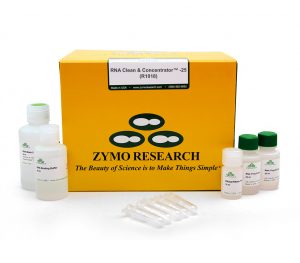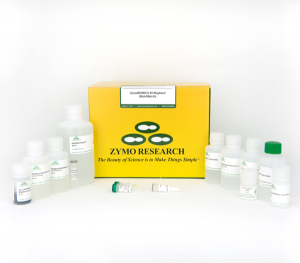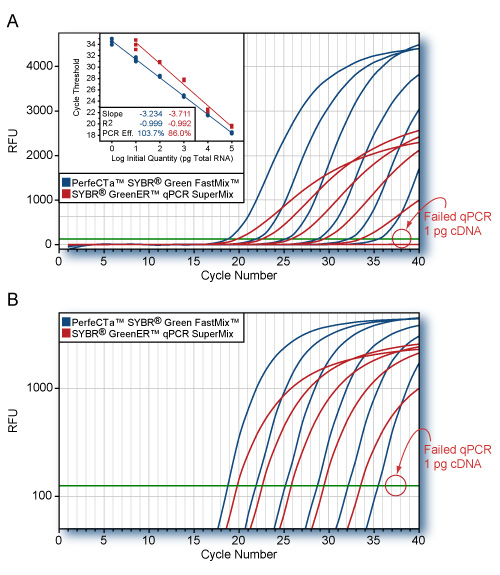AccuStart II PCR SuperMix
| Products | Kit Size | Order Info |
|---|---|---|
| AccuStart II PCR SuperMix | 100 x 25 µL rxns (1 x 1.25 mL) | Order (95137-100) |
| 500 x 25 μL rxns (5 x 1.25 mL) | Order (95137-500) | |
| 4000 x 25 μL rxns (1 x 50 mL) | Order (95137-04K) |
Documents
Description
Robust, user-friendly 1-tube PCR SuperMix reagents for routine, general purpose PCR
Features & Benefits
- User-friendly 2X concentrated master mix simplifies reaction setup with exceptional room-temperature stability (≥30 days at 22°C) and is impervious to repetitive freeze-thaw (≥ 20X)
- High-yielding, ultrapure modified Taq DNA polymerase delivers robust, reliable assay sensitivity
- Stringent, ultrapure antibody hotstart ensures sensitive and precise target amplification
AccuStart II PCR SuperMix is intended for molecular biology applications. This product is not intended for the diagnosis, prevention or treatment of a disease.
Description
AccuStart II PCR SuperMix is a 2X concentrated, ready-to-use reaction cocktail for routine PCR amplification of DNA fragments up to 4 kb. It contains all components, except primers and template. AccuStart II PCR SuperMix simplifies reaction assembly, improves assay reproducibility, and reduces the risk of contamination. A key component is AccuStart™ II Taq DNA polymerase which contains monoclonal antibodies that bind to the polymerase and keep it inactive prior to the initial PCR denaturation step. Upon heat activation (1 minute at 94°C), the antibodies denature irreversibly, releasing fully active, unmodified Taq DNA polymerase. This enables specific and efficient primer extension with the convenience of room temperature reaction assembly.
Store components in a constant temperature freezer at -25°C to -15°C upon receipt. Repeated freezing and thawing does not impair product performance. For lot specific expiry date, refer to package label, Certificate of Analysis or Product Specification Form.
Product Manuals
Publications
AMichelle A. Gordy, Parasitology Research – 2016
ABSTRACT
Digenean trematode distributions, compatibility profiles with their snail hosts, and complete life cycles remain mysteries in many parts of the world. Surveys of digenean biology and ecology provide further insight and perspective into just how incredibly diverse and important helminth parasites are in shaping local ecosystems. Past surveys have provided substantial characterizations of adult digeneans within their definitive hosts, and many now have contributed toward furthering our understanding of larval digeneans within their intermediate host communities. However, much information about the diversity of digeneans and their relationships with their snail intermediate hosts are lacking in many locations across the globe. This is certainly true in Canada, where few records related to digenean-snail relationships exist. Currently, there is a need for more information about the presence and distribution of digeneans across Canada, and how this compares to other parts of North America and beyond. To address this diversity gap in Western Canada, six lakes within central Alberta were surveyed for the presence of snails and larval digenean species and their associations. This investigation into the diversity of digeneans utilized a combined approach of morphological and molecular tools to identify 39 digenean species among five snail host species, from biweekly collections, taken over the course of 2 years (2013–2014). Here, digenean-snail combinations, presence, and distribution across sampling sites and lakes are reported. Overall, this survey contributes new information toward digenean-snail compatibility, life cycles, and distribution in Northern lake ecosystems within North America.
Radiation of the polymorphic Little Devil poison frog (Oophaga sylvatica) in Ecuador
Alexandre B. Roland, Ecology and Evolution – 2017
ABSTRACT
Some South American poison frogs (Dendrobatidae) are chemically defended and use bright aposematic colors to warn potential predators of their unpalatability. Aposematic signals are often frequency-dependent where individuals deviating from a local model are at a higher risk of predation. However, extreme diversity in the aposematic signal has been documented in poison frogs, especially in Oophaga. Here, we explore the phylogeographic pattern among color-divergent populations of the Little Devil poison frog Oophaga sylvatica by analyzing population structure and genetic differentiation to evaluate which processes could account for color diversity within and among populations. With a combination of PCR amplicons (three mitochondrial and three nuclear markers) and genome-wide markers from a double-digested RAD (ddRAD) approach, we characterized the phylogenetic and genetic structure of 199 individuals from 13 populations (12 monomorphic and 1 polymorphic) across the O. sylvatica distribution. Individuals segregated into two main lineages by their northern or southern latitudinal distribution. A high level of genetic and phenotypic polymorphism within the northern lineage suggests ongoing gene flow. In contrast, low levels of genetic differentiation were detected among the southern lineage populations and support recent range expansions from populations in the northern lineage. We propose that a combination of climatic gradients and structured landscapes might be promoting gene flow and phylogenetic diversification. Alternatively, we cannot rule out that the observed phenotypic and genomic variations are the result of genetic drift on near or neutral alleles in a small number of genes.
Safety Data Sheets (SDS)
CofA (PSF)
PSF-95137-500-Lot#020104
PSF-95137-04K-Lot#022196
PSF-95137-04K-Lot#022592
PSF-95137-500 PSF-Lot#022234
PSF-95137-500-Lot#022136
PSF-95137-500-Lot#022235
PSF-95137-500-Lot#025047
PSF-95137-100-Lot#025287
PSF-95137-500-Lot#025288
PSF-95137-04K-Lot#025893
PSF-95137-100-Lot#026574
PSF-95137-04K-Lot#027075
PSF-95137-500-Lot#027096
PSF-95137-100-Lot#027214
PSF-95137-100-Lot#027747
PSF-95137-500-Lot#027748
PSF-95137-500-Lot#027749
PSF-95137-100-Lot#027939
PSF-95137-500-Lot#028176
PSF-95137-04K-Lot#028912
PSF-95137-500-Lot#030500
PSF-95137-04K-LOT#66141463
PSF-95137-100-LOT#66141464
PSF-95137-500-LOT#66151211









